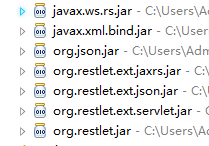1、示例说明
版本:Restlet版本为2.1.0。
另外:这个应该是才开始接触级别的示例,刚学者可以作为借鉴看看,大神请深藏您的功与名。
2、关于Restlet
(1)、官网:http://restlet.org/
(2)、原则:为所有“事物”即资源定义ID;将所有事物链接在一起;使用标准方法,即CRUD;资源多重表述;无状态通信。具体描述谷歌搜索。
3、创建Java Web工程,添加相关Jar。文中示例工程名为JAXRSRestlet
4、创建Model,示例为Student
public class Student {
private Integer id;
private String name;
private Integer sex;
private Integer age;
public Student() {
}
/**setter/getter**/
}5、创建BusinessObject类,示例虚拟了一个数据库和相应的一些操作
public class StudentBO {
private static Map<Integer, Student> students = new HashMap<Integer, Student>();
// next Id
private static int nextId = 5;
static {
students.put(1, new Student(1, "Michael", 1, 18));
students.put(2, new Student(2, "Anthony", 1, 22));
students.put(3, new Student(3, "Isabella", 0, 19));
students.put(4, new Student(4, "Aiden", 1, 20));
}
public Student getStudent(Integer id) {
return students.get(id);
}
public List<Student> getStudentAll() {
return new ArrayList<Student>(students.values());
}
public Integer saveOrUpdateStudent(Student student) {
if (student.getId() == null) {
student.setId(nextId++);
}
students.put(student.getId(), student);
return student.getId();
}
public Integer removeStudent(Integer id) {
students.remove(id);
return id;
}
}6、创建对应的Resource类,具体看注释
//student路径进来的都会调用StudentResource来处理
@Path("student")
public class StudentResource {
StudentBO studentBO = new StudentBO();
// 说明了http的方法是get方法
@GET
// 每个方法前都有对应path,用来申明对应uri路径
@Path("{id}/xml")
// 指定返回的数据格式为xml
@Produces("application/xml")
// 接受传递进来的id值,其中id为Path中的{id},注意定义的占位符与@PathParam要一致
public Student getStudentXml(@PathParam("id") int id) {
return studentBO.getStudent(id);
}
@GET
@Path("{id}/json")
@Produces("application/json")
public Student getStudentJson(@PathParam("id") int id) {
return studentBO.getStudent(id);
}
@POST
@Path("post")
public String addStudent(Representation entity) {
Form form = new Form(entity);
String name = form.getFirstValue("name");
int sex = Integer.parseInt(form.getFirstValue("sex"));
int age = Integer.parseInt(form.getFirstValue("age"));
Student student = new Student();
student.setName(name);
student.setSex(sex);
student.setAge(age);
int i = studentBO.saveOrUpdateStudent(student);
return i + "";
}
@PUT
@Path("put")
public String updateStudent(Representation entity) {
Form form = new Form(entity);
int id = Integer.parseInt(form.getFirstValue("id"));
String name = form.getFirstValue("name");
int sex = Integer.parseInt(form.getFirstValue("sex"));
int age = Integer.parseInt(form.getFirstValue("age"));
Student student = new Student();
student.setId(id);
student.setName(name);
student.setSex(sex);
student.setAge(age);
int i = studentBO.saveOrUpdateStudent(student);
return i + "";
}
}7、扩展javax.ws.rs.core.Application类
public class StudentApplication extends Application {
@Override
public Set<Class<?>> getClasses() {
Set<Class<?>> rrcs = new HashSet<Class<?>>();
// 绑定StudentResource。有多个资源可以在这里绑定。
rrcs.add(StudentResource.class);
return rrcs;
}
}
8、扩展org.restlet.ext.jaxrs.JaxRsApplication类
public class RestJaxRsApplication extends JaxRsApplication {
public RestJaxRsApplication(Context context) {
super(context);
//将StudentApplication加入了运行环境中,如果有多个Application可以在此绑定
this.add(new StudentApplication());
}
}
9、web.xml配置
<context-param>
<param-name>org.restlet.application</param-name>
<param-value>app.RestJaxRsApplication</param-value>
</context-param>
<servlet>
<servlet-name>RestletServlet</servlet-name>
<servlet-class>org.restlet.ext.servlet.ServerServlet</servlet-class>
</servlet>
<servlet-mapping>
<servlet-name>RestletServlet</servlet-name>
<url-pattern>/*</url-pattern>
</servlet-mapping>
10、Client端测试
/**
* 示例使用了Junit,不用可以写Main方法
*/
public class Client {
public static String url = "http://127.0.0.1:8080/JAXRSRestlet/";
@Test
public void testGetXml() {
ClientResource client = new ClientResource(url + "student/1/xml");
try {
System.out.println(client.get().getText());
} catch (ResourceException e) {
e.printStackTrace();
} catch (IOException e) {
e.printStackTrace();
}
}
@Test
public void testGetJson() {
ClientResource client = new ClientResource(url + "student/1/json");
try {
System.out.println(client.get().getText());
} catch (ResourceException e) {
e.printStackTrace();
} catch (IOException e) {
e.printStackTrace();
}
}
@Test
public void testPost() {
ClientResource client = new ClientResource(url + "student/post");
try {
Form form = new Form();
form.add("name", "testPost");
form.add("age", "0");
form.add("sex", "39");
String id = client.post(form.getWebRepresentation()).getText();
System.out.println(id);
} catch (Exception e) {
e.printStackTrace();
}
}
@Test
public void testPut() {
ClientResource client = new ClientResource(url + "student/put");
try {
Form form = new Form();
form.add("id", "1");
form.add("name", "testPut");
form.add("age", "22");
form.add("sex", "0");
String id = client.put(form.getWebRepresentation()).getText();
System.out.println(id);
} catch (Exception e) {
e.printStackTrace();
}
}
@Test
public void testDelete() {
ClientResource client = new ClientResource(url + "student/1");
try {
System.out.println(client.delete().getText());
} catch (ResourceException e) {
e.printStackTrace();
} catch (IOException e) {
e.printStackTrace();
}
}
}
1、输出结果
(1)、testGetXml():<?xml version="1.0" encoding="UTF-8" standalone="yes"?>
<Student><age>18</age><id>1</id><name>Michael</name><sex>1</sex></Student>
(2)、testGetJson:{"id":1,"sex":1,"age":18,"name":"Michael"}
(3)、testPut():1
再调用testGetJson()传入{id}=1时:{"id":1,"sex":0,"age":22,"name":"testPut"}
(4)、testPost():5
再调用testGetJson()传入{id}=5时:{"id":5,"sex":39,"age":0,"name":"testPost"}
转载于:https://blog.51cto.com/racoguo/1241139




 本文介绍如何使用Restlet框架实现RESTful服务,包括创建Java Web工程、定义资源模型、实现资源操作及客户端测试等步骤。
本文介绍如何使用Restlet框架实现RESTful服务,包括创建Java Web工程、定义资源模型、实现资源操作及客户端测试等步骤。

















 165
165

 被折叠的 条评论
为什么被折叠?
被折叠的 条评论
为什么被折叠?








